Evolutionary Bio Prelim #2
1/189
There's no tags or description
Looks like no tags are added yet.
Name | Mastery | Learn | Test | Matching | Spaced |
|---|
No study sessions yet.
190 Terms
Adaptations and Speciations 3
Two-fold cost of sex:
asexual organisms can multiply faster and don’t rely on other organisms
Asexual grows at a rate of 2^n
Doubles EVERY generation
Sexual can only produce 1 offspring for each reproduction
Costs of sexual reproduction:
Requires finding an appropriate mate
Parents are less related (0.5 vs. 1)
Risk of contracting sexually transmitted diseases
Recombination
formation of new allelic combinations in offspring. Occur during meiosis via the cross over between homologous chromosomes (in eukaryotes)
Genetic exchange can occur in bacteria but the recombination is basically just reproduction
Muller’s Ratchet
The entire genome in asexual lineages is passed down
Deleterious mutations can accumulate
Results in genetic load - reduction with selective value compared to if all genomes had favorable genes
The Red Queen Effect:
when a trait is ideal there is RAPID increase in that population, but when that population is too high competition is massive, causing a crash.
sexual selection
Form of natural selection which results from differential reproductive success among individuals
Aka individuals that possess trait that help them to reproduce WILL be favored by sexual selection
sexual dimorphism
A phenotypic difference between the male and female population
Can differ in:
Behavior
Physiology
Morphology (color,size, weapons)
Body size
Male sea lions are larger
Same size in gre mouse and lemus
Females larger in great horned owls and anglerfish
operational sex ratio
The ratio of males ot females available for reproducing at any given time
Garter snake: 64:1 males to females
Results in a “male biased” operational sex ratio
Stronger sexual selection on males
Operational sex ratio under male-biase
Males: invest in fertilizing eggs (many more males than females will not be able to mate at all)
Females: not limited by the ability to mate
Can choose good mates
operational sex ratio under female-bias
Females:invest in attracting mates
Males are not limited in the ability to mate
Invest in choosing high quality mate
Take care of offspring
Wattled Jacana
intrasexual selection
Mating competitions
Usually males compete amongst males
Fights get violent if there is a big male-biased ratio
Post-copulatory intrasexual competition
Sperm from multiple males compete to fertilize the same egg
Aka sperm competition
Larger testes, more sperm
Produce a lot of sperm
Remove sperm that is already there
Fruit flies have spikes that can remove sperm that was previously there
Mechanisms that prevent sperm from being addd later
Fruit flies seminal proteins make the females want to breed less later
intersexual selection
An individual selects their mates based on characteristics exhibited by the oppositve sex
senescence
decline in performance while aging
antagonistic coevolution
dynamics between competing specios or traits, where adaptations in 1 party drive counter-adaptations in another
predatory-prey
host-parasite
Adaptation and Speciation 4
phenetic vs. biological species concept
Phenetic Species Concepts
Use morphological traits to define species
Are readability observable
Species: the smallest possible groups whose members are descended from a common ancestor and who all possess characteristics that distinguish them from other groups
Species is a tip on the phylogenetic tree
Limitation: relies on having an accurate phylogeny
Biological Species Concept
Species: a group of actually or potentially interbreeding populations that are reproductively isolated from other groups
Advantages:
No trouble with different morphs within a species/cryptic species
Does not requiere human interpretation of morphology/ detailed phylogenetic info
Disadvantages:
What is meant by potentially interbreeding?
metapopulation
a group of spatially separated populations of the same species that exchange individuals/genes to at least some degree
2 methods for new species arising
Barrier to gene flow
1.Georgraphical barriers (extrinsic)
Mountains, rivers
physical barrier
Allopatric speciation, peripatric speciation
2.Reproductive Barriers (intrinsic)
Mating preferences, hybrid incompatibilities
Evolutionary divergences which prevent gene flow
Parapatric speciation, sympatric speciation
speciation
the formation of new species
allopatric (allo=other, patric=place)
occurs when populations are separated by an extrinsic geographic barrier
sympatric (sym=same, patric= place)
Some individuals begin to exploit a new niche, and mate only with other who do the same
parapatric (para=beside, patric=place)
Occurs when species are spread out over a large geographic area, but mate only with those that live close to them
continuously distributed pop
Poluted soils vs. good soils may deviate into 2 species
peripatric (peri=near, patric=place)
small number of individuals are separated from the main population by migrating
vicariance
The formation of geographic barriers that separate a population
Ex: shrimp species on either size of central america used to be 1 species (formation of Panama separated gene contact)
gametic incompatibility
Sperm cannot feritlize egg
Lack receptors on egg for fertilization
premating barriers
Behavioral isolation
Fireflies - different flashing patterns amongst different species
Ecological isolation
Habitat
Temporal
Apple maggot fly
Some maggots who laid eggs on apples started breeding earlier in the year
Became more temporally separated (formed new species)
Pollinator isolation
Mechanical isolation
Differences in male genitalia
prezygotic reproductive barriers
Copulatory behavioral isolation
Species-specific behaviors during copulation may be necessary for fertilization
E: tapping behavior in Orchid Mantis
Will be rejected if tapping is incorrect
Gametic isolation
Sperm cannot feritlize egg
Lack receptors on egg for fertilization
postzygotic reproductive barriers
Intrinsic
Hybrid indiviability
Hybrid sterility
Hybrids are unable to reproduce (mules)
Extrinsic - hybrids are less fit in some environments
Ecological inviability
Behavioral sterility
Can’t obtain mates but are able to reproduce
Ex: hybrid grasshoppers can’t make the correct rubbing signal
what does reinforcement do to with natural selection?
Natural selection leads from postzygotic to prezygotic isolation, and the formation of new species through reinforcement
fusion
If divergence results in no prepzygotic or postzygotic isolation, and populations that come into secondary contact interpreed, they can become one species
primary hybrid zone
Population A and Population B have no physical barrier separating them
secondary hybrid zone
Population that have diverged in allopatry come back together
Have extrinsic separation that disappeared
Usually have much less offspring
Reinforcement AGAINST hybrid population
Selection against hybrid offspring increase separation
Macroevolution 2
standing diversity
Standing diversity12 = standing diversity11 + origination - extinction
Each line represents the time where a taxon existed
Count the number of taxa present at the beginning of stage B
origination
species that appeared during the current stage
2 types of extinction (bacground rate and mass extinction)
Background rate:
“Ordinary extinction” with a variety of causes
Changing climate
Loss of food resource
Predation, disease, competition
Mass extinction:
Statistically significant departure from background rates
Involve the extinction of many clades
in a graph it is the last appearance of that species in that stage
adaptive radiation
rapid diversification into many forms over a short period of time
Mass extinctions and/or background extinctions can open up niches to allow other organisms to evolve. However, rapid evolution into many forms, or adaptive radiations, doesn’t only occur because of extinctions
Example: Darwin’s finches on the Galapagos Islands
Many new habitats, which allowed for rapid evolution
Honeycreepers on Hawaiian Islands
Evolved to occupy new niches for volcanic activity
50 in 5 MY
character displacement
Competition between species for a resource or niche species for a resource or niche drives evolution of different traits.
Cambrian Explosion
541 MYA
rapid diversification of life forms
Sepkoski’s curve
Marine invertebrates families
X-axis is periods
Mass extinctions are A-E
Sepkoski’s curve extinction A
60% 450 MYA
Sepkoski’s curve extinction B
70% of species 375 MYA
Sepkoski’s curve extinction C
Permian extinction
96% of species 250 MYA
Large volcanic eruption in Siberia
Released a lot of CO2 and methane
Characters:
Increase in temp
Increase in CO2 in oceans
End of the Trilobites
Marine arthoropods
Marks the boundary between the permian and the triassic
Sepkoski’s curve extinction D
75% of species 200 MYA
Sepkoski’s curve extinction E
Kpg extinction (Cretaceous-Paleogene extinction)
Occurs at the end of the Cretaceous and the beginning of the Paleogene
75% species 65 MYA
Massive asteroid hit near the golf of mexico
Killed all non-avian dinosaurs
Extinctions:
Pterosaurs, marive reptiles, many insects, plants
Opened up many niches for birds to radiate with the loss of dinosaurs
anagenesis
mode of evolution; slow evolution
cladogenesis
stasis followed by rapid evolution (fast tempo)
punctuated equilibria
Morphological change occurs relatively rapid associated with splitting of lineages (cladeogenesis, typically through allopatric orperipatric speciation)
followed by long periods of stasis
stasis
no net change is fossil reccords
sympatric speciation
Some individuals begin to explot a new niche, and mate only with others that do the same
Certain food ex.
Biodiversity 3
glaucophytes
unicellular algae at the base of the plant clade
Only have asexual reproduction
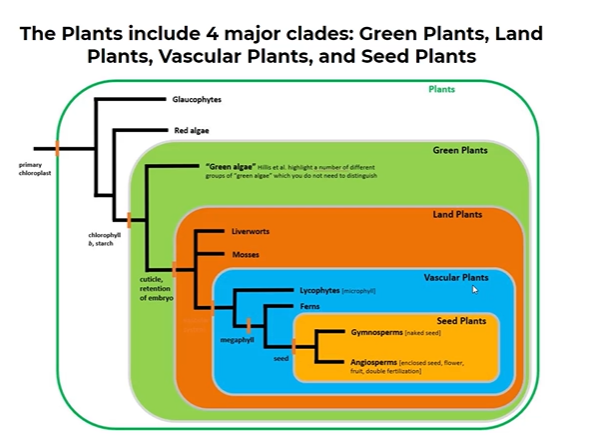
“Green Algae”
form a polytomy and is sister to land plants
can be uni or multicellular
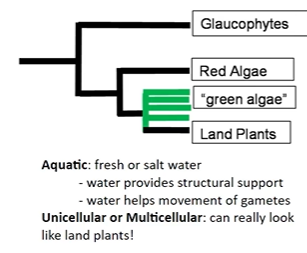
Red algae
Marine
Do not have chlorophyll b or starch (not green plant)
Make more chlorophyll A
Sister group to green plants (which have chlorophyll b, and starch)
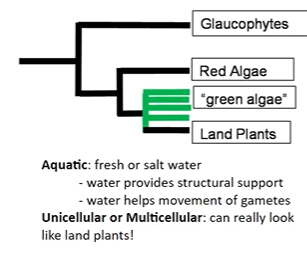
Green Plants
Synapomorphy = chlorophyll b and starch as storage protein
Largest clade
Have chlorophyll b and starch
Permits photosynthesis
Extends wavelengths that can be absorbed (effective at different wavelengths)
Allowed plants to go from aquatic to land
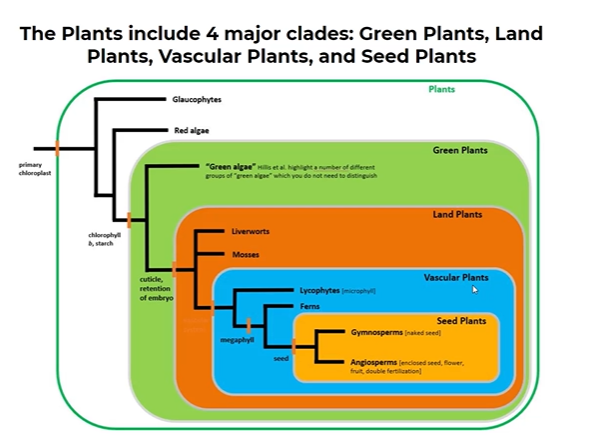
challanges of going from water → land
Desiccation
Physical support
Movement of fluids/nutrients without free flowing water
Protect gametes
Increased UV radiation
Land Plants - characteristics
Waxy coat (cuticle) to help prevent water loss
Retention of embryo
Latex cover
Seeds
Plant body evolved to have phloem and xylem
Xylem allow for movement of water
Phloem is movement of nutrience
Stomata allow for water and gas exchange
Generational alternation in Land Plant
2n sporophyte stage produce haploid spores (n) gametophyte stage
Will fuse again during fertilization to form a diploid zygote
The fertilized egg will develop into a diploid sporophyte
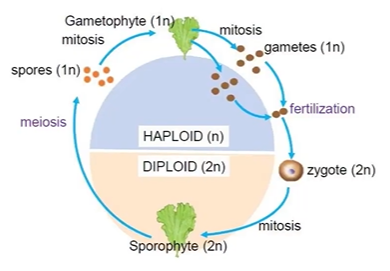
nonvascular land plants
characteristics:
Gametophyte is large and haploid
Sporophyte is small and attached to gametophyte
non-seeded
need water for fertilization
liverworts
low to the group
mosses
Simple fluid-transport (not considered vascular)
Larger and more complex than liverworts
Vascular Plants
large sporophyte
Lycophte, ferns, seed plants, gymnosperms, angiosperms
Unified by having phloem and xylem
Spend most of their life in sporophyte generation
Plants spend longer and gets bigger in sporophyte stage than in gametophyte stage
sperm is carried in pollen grain
Lycophytes
Have a microphyll (synaporphy) with 1 vein (simpler leaves)
Has a vascular system
Dominant in Carboniferous period
LARGE sporophyte
Ferns
Megaphylls - more complicated leaves
United with seed plants for megaphylic (synapomorphy)
LARGe sporophyte
Seed Plants
sperm is carried in pollen grain
type of vascular plant (large sporophyre, small gametophyte)
synapomorphy = seed
2 types:
gymnosperm
angiosperm
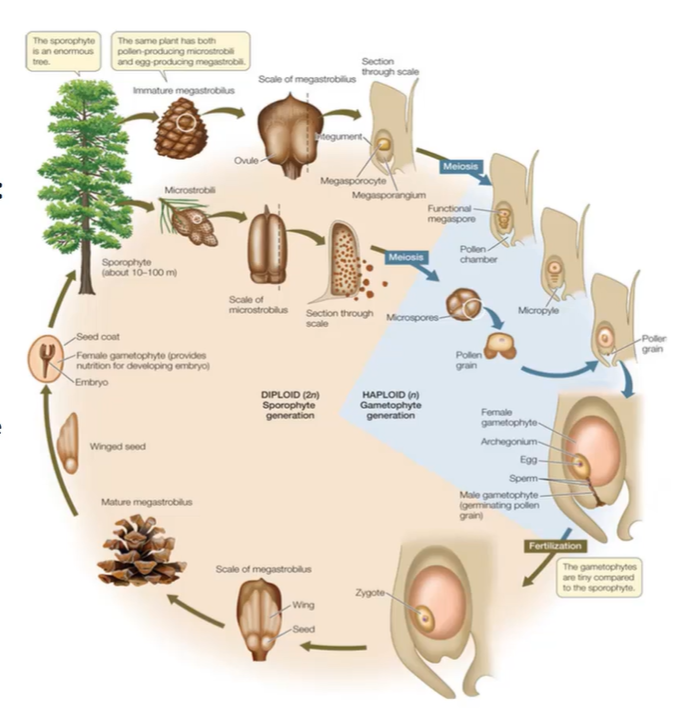
Gymnosperm
naked seed
reproduction
Pollen grain lands on female gametophyte (cone) and males pollen tubes
Pollen tubes deliver sperm that fertilizes the egg
Ovule develops into seed
Resistant to drying out and has nutrients
Angiosperm (Flowering Plants)
Sporophyte plant produces spore that are haploid
Grown into multicellular male and female haploid gametophytes
Flower is part of the sporophyte plant + it is diploid
Part of the carpels on the flower is the ovary
Also sporophyte tissue
In the ovary are the ovules
Also sporophyte, will produce the spores that become the female gametophyte
Contains some haploid gametophyte tissue + haploid egg cell
Some cells of the pollen grain become the pollen tubes while other are the sperm
Pollen make pollen tubes
Will deliver sperm to egg
This is double fertilization
1 sperm fert. The egg
The other sperm fuses with the 2 nuclei to make a triploid endosperm
Extra nutrients for the embryo
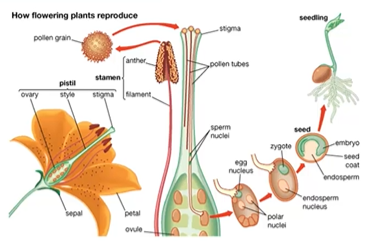
stomata
pores on the leaf that allow gas and water exchange
chlorophylls a and b
a → in red algae + green plants
b→ in green plants
extend wavelengths that can be absorbed
haploid vs. diploid
haploid → n
most meiosis to fertilization
includes gametophyte
diploid → 2n
post fertilization (zygote) to meiosis
includes sporophyte
sporophyte
asexual (and usually diploid) phase
produces spore from which the gametophyte arises
dominant in vascular plants
spore
becomes the female gametophyte
holds some haploid gamtophyte tissue + haploid egg cell
gametophyte
usually 1n (haploid)
produces gametes through mitosis which will fertilize to make a zygote
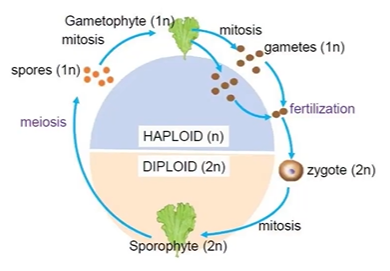
gamete
(egg/sperm)
mature haploid male/female germ cell ready to unite with another to form a zygote
microphylls vs. megaphylls
microphylls
synapomorphy for lycophytes
1 vein (simpler leaves)
megaphylls
more complicated leaves
united with seed plants for megaphyll (synapomorphy)
enclosed seeds
seedds with hard flesh around it in angiosperms
protects seed
flowering plants
naked seed
gymnosperms
non-flowering
not enclosed by a cone or fruit
rely on wind for pollination
xylem vs. phloem
xylem carries water through vascular system while phloem carries nutrience and waste
pollen
male gametophyte
Some cells of the pollen grain become the pollen tubes while other are the sperm
Pollen make pollen tubes
double fertilization
1 sperm fert. The egg
The other sperm fuses with the 2 nuclei to make a triploid endosperm
Extra nutrients for the embryo
stamen
male fertilizing organ of a flower
includes pollen anther and a filament
anther
part of stamen containing the pollen
ovary
part of the carpels on the flower or the sporophyte tissue (fruit)
contains the ovules
primary chloroplast
cyanobacteria engulfed by eukarya
endosperm
triploid biproduct of double fertilization
arbuscular mycorrhizal fungi
type of fungi
Form mycorrhizae with 90% of plants
Relationship
Fungus gets photosynthate
Plants get increased SA for acquisition of soil nutrients
Ascomycota
Ascomycota
sac/cup fungi
Produce spores in an ascus
When it bursts from pressure
Ex: morels, truffles, most yeast/molds, most lichens
Yeast: any single-celled fungi
Model organism is brewers yeast
Lichens: usually ascomycete, photobionts, green alga and/or cyanobacterium
Slow growth and complicated
Able to tolerate extreme conditions
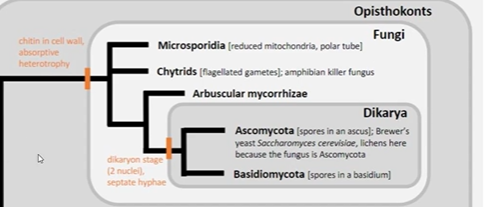
Basidiomycota
Club fungi
Produce spores on a basidium
Produces/discharge passively
Examples: rust, smut, mushrooms, brackets
rusts/smuts:
Serious pathogens
Brackets: on sides of live/dead trees
Mushrooms:
Fruiting bodies grow from undergroud mycellium
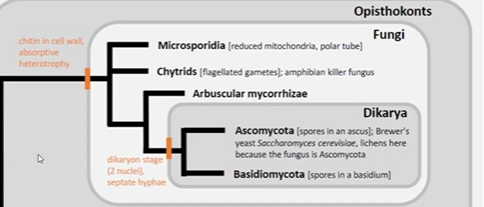
“chytrids”
Paraphyletic group
Synapomorphy: flagellated gametes that is used to swim in water
Only fugus with flagella
Famous for killing frogs
Can be uni or multicellular
Asexual and sexual reproduction
Mostly saprobic (eat decaying matter) but a few are parasitic
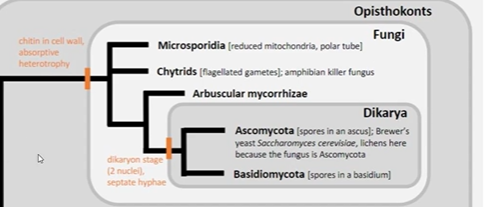
Dikarya
Dikarya
Synapomorphie: dikaryon stage (2 nuclei), septate hyphae
Reproduce sexually (2n+) and asexually (n)
For sexual reproduction there is no distinguisting characteristics between male and female
A combination of 2 genetic strains
Have septate hyphae
Can control movement of cytoplasm and organelles
2 major groups
Ascomycota
Basidiomycota
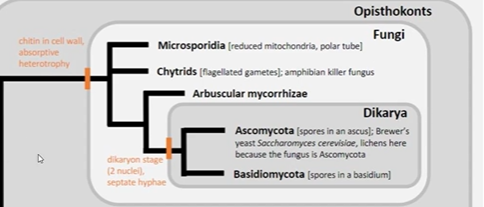
fungi
United with animal and choanoflagalletes in the opishtokonts by the syampomorphy (single posterior flagellum)
fungi bodies
Tubular filaments of the body of fungi (called hyphae) that allow organic materials and organelles to pass)
A large collection of hyphae is called mycelium
Synamporphies:
Chitin in the cell wall
Absorptive heterotrophy (form of nutrient acquisition)
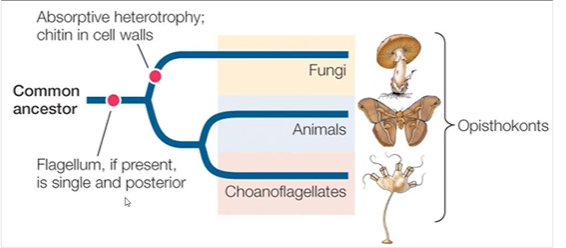
lichens
Lichens: usually ascomycete, photobionts, green algae and/or cyanobacterium
type of ascomycota
Slow growth and complicated
Able to tolerate extreme conditions
Microsporida
One of the main groups of FUNGI
Small, unicellular parasitic
Synapomorphy: reduced mitochondria, polar tube
Polar tube: infect host cell
dangerous!
Opisthokonts
Clade including animalia, fungi, and Choanoflagellates
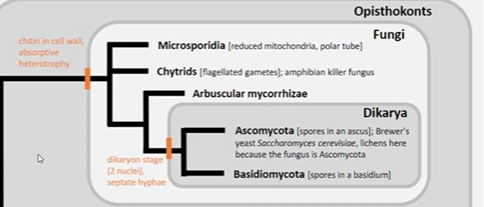
Saccharomyces cerevisiae
brewers yeast,
type of Ascomycota, which is a type of Dikarya
absorptive heterotroph
synapomorphy of fungi
secretes digestive enzymes to externally absorb nutrients
ascus
where ascomycota sac fungi produce spores
burst from pressure
basidium
where basidiomycota produce spores
are produced and discharge passively
dikaryotic
2 genetically distinct nuclei within 1 cell
chitin
what fungal cell walls are made of
also in the exoskeleton of bugs
hyphae
tubular filaments of the body of fungi
allows organic materials and organelles to pass